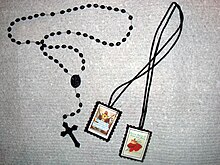

The topic of this article may not meet Wikipedia's general notability guideline. (August 2022) |
The exact origins of both the rosary and scapular are subject to debate among scholars. Pious tradition maintains that both the rosary and the brown Scapular of Our Lady of Mount Carmel were given by the Virgin Mary to Dominic and Simon Stock respectively during the 13th century.[1] Historical records document their growth during the 16th and 17th centuries in Europe. By the early 20th century, they had gained such a strong following among Catholics worldwide that Josef Hilgers, writing in the Catholic Encyclopedia of 1914, stated: "Like the Rosary, the Brown scapular has become the badge of the devout Catholic."[2]
Since the Second Vatican Council, the more appropriate term for these items is "devotional articles", in order to distinguish them from liturgical actions and items used therewith, such as candles, chrism, or sprinkling with holy water.[3]
As with all religious articles, the use of the rosary and the scapular are optional for Roman Catholics. Specific indulgences have been associated with each of them.[4] This article reviews the history, Mariology and the development of the rosary and the scapular as important expressions of popular piety in the Roman Catholic Church.
- ^ Saunders, William. "History of the Rosary", The Arlington Catholic Herald, October 6, 1994
- ^ "Scapular", The Catholic Encyclopedia, Vol. 13, New York: Robert Appleton Company, 1912. 22 Dec. 2014.
- ^ Catechism of the Catholic Church §1674
- ^ Vatican website for Pope Paul VI's Apostolic Constitution Indulgentiarum Doctrina [1]
© MMXXIII Rich X Search. We shall prevail. All rights reserved. Rich X Search
